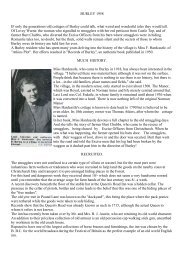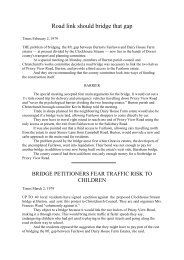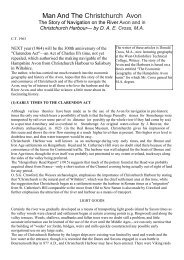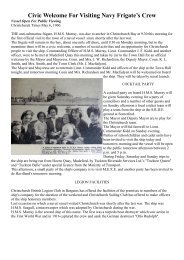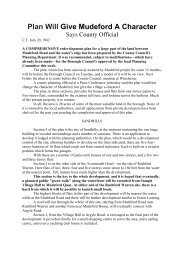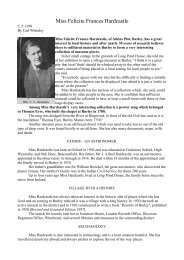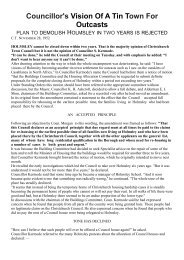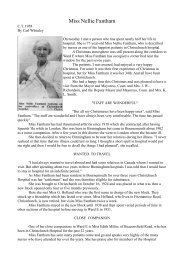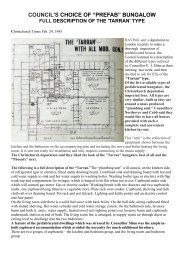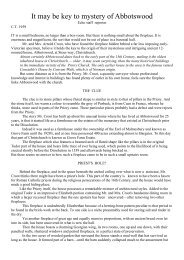HIGHCLIFFE 1958 (Part 1). The story of Highcliffe ... - royhodges.co.uk
HIGHCLIFFE 1958 (Part 1). The story of Highcliffe ... - royhodges.co.uk
HIGHCLIFFE 1958 (Part 1). The story of Highcliffe ... - royhodges.co.uk
Create successful ePaper yourself
Turn your PDF publications into a flip-book with our unique Google optimized e-Paper software.
<strong>HIGHCLIFFE</strong> <strong>1958</strong> (<strong>Part</strong> 1).<br />
<strong>The</strong> <strong>story</strong> <strong>of</strong> <strong>Highcliffe</strong> is rich and full <strong>of</strong> romantic hi<strong>story</strong>. It is a <strong>story</strong> which revolves round a castle, once<br />
described as "a fairy palace by the sea."<br />
And <strong>of</strong> the many famous historical personalities who visited the castle some <strong>of</strong> them were drawn by the<br />
enchantment <strong>of</strong> the spot.<br />
When the third Earl <strong>of</strong> Bute stood on the cliff at its highest point, just opposite the Needles, the full beauty<br />
<strong>of</strong> the landscape caught his enthusiastic eye. "It is fairest outlook in all England,” was his remark.<br />
He lost no time sending for his architect, Robert Adam, and there and then <strong>co</strong>mmissioned him to build a<br />
house.<br />
<strong>The</strong> Earl was a keen botanist and had been hunting the New Forest for some rare specimens. <strong>The</strong> end <strong>of</strong> his<br />
search brought him to the fringe <strong>of</strong> the forest and the edge <strong>of</strong> the sea.<br />
A wonderful prospect it was in those days, when only the fishermen's huts at the entrance <strong>of</strong> the harbour,<br />
and a few discreet houses at Mudeford arrested the eye for a moment till the square tower <strong>of</strong> the Priory came<br />
in view and, beyond, the blue, undulating lines <strong>of</strong> the Purbeck Hills.<br />
WENT TO AMERICA.<br />
A photo <strong>of</strong> the waterfall at Chewton<br />
Glen or Bunny,a favourite spot for<br />
holiday makers.<br />
<strong>The</strong> Bunny, as it is called locally,<br />
extends from the bridge, where the<br />
Lymington Road crosses the brook, to<br />
the sea, and a footpath winds its way<br />
through the whole length <strong>of</strong> the<br />
beautiful wooded glen.<br />
About half way down the Bunny is<br />
Mill House, now a charming private<br />
residence,but once a water mill.<br />
It was from <strong>Highcliffe</strong> that Lord Bute and his youngest daughter, Louisa, watched the vessel that bore away<br />
his favourite son, Charles, when he went out to America to join his regiment, then engaged in the War <strong>of</strong><br />
Independence.<br />
Sadly these two turned away from the horizon, empty now <strong>of</strong> the sailing <strong>co</strong>nvoy. For Louisa it meant not<br />
only parting from an adored brother, but from that brother's greatest friend, William Medows, who had won<br />
Louisa's heart, only to be told by the young lady's parent that he was too insignificant to be <strong>co</strong>nsidered as a<br />
suitor for her hand.<br />
If there are ghosts, then the cliff walk at <strong>Highcliffe</strong> must surely be haunted by the wistful Louisa, who<br />
renounced a lover at the behest <strong>of</strong> a father, and to the end <strong>of</strong> a very long life abjured marriage, devoting to<br />
friends and relatives those <strong>co</strong>nsiderable gifts which earned for her the pr<strong>of</strong>ound esteem <strong>of</strong> Sir Walter S<strong>co</strong>tt.<br />
She was one <strong>of</strong> the few initiated into the secret <strong>of</strong> the authorship <strong>of</strong> the Waverley novels, but she never<br />
succumbed to Sir Walter’s earnest persuasions to publish writings <strong>of</strong> her own.
Lord Bute's death in 1792 was indirectly caused by the pursuit <strong>of</strong> his favourite hobby. Reaching after a rare<br />
specimen on the steep face <strong>of</strong> the cliff, he slipped and fell, injuring himself internally. His death ensued two<br />
years later.<br />
<strong>The</strong> house did not long survive him, owing to the fact that his son who inherited it, Charles the soldier,<br />
<strong>co</strong>uld not afford to keep up so great a mansion and because his pr<strong>of</strong>essional duties precluded residence<br />
there.<br />
So an 11-day sale scattered the <strong>co</strong>ntents and the building was pulled down, the site reverting to its original<br />
loneliness—the nesting place <strong>of</strong> wild birds, the haunt <strong>of</strong> the foxes and the chosen landing ground <strong>of</strong><br />
smugglers.<br />
<strong>The</strong> present <strong>Highcliffe</strong> Castle was built in 1830-40 by the Ambassador Lord Stuart de Rothesay with<br />
materials <strong>of</strong> the Manoir des Andelys, near Rouen, to replace a house built in 1773 by his grandfather, John,<br />
third Earl <strong>of</strong> Bute, the Prime Minister.<br />
Lord Stuart de Rothesay, a great diplomat, retired to the present castle. His two daughters, Charlotte and<br />
Louisa, were both noted beauties. Charlotte married Vis<strong>co</strong>unt Canning, the first Viceroy <strong>of</strong> India and Louisa<br />
married the Marquis <strong>of</strong> Waterford.<br />
In the se<strong>co</strong>nd half <strong>of</strong> the 19thcentury and the early years <strong>of</strong> the 20th century <strong>Highcliffe</strong> Castle had many<br />
distinguished guests and was on occasions, let to tenants, including Sir Harold Harmsworth and Mr. Gordon<br />
Selfridge.<br />
CROWN PRINCE'S VISIT.<br />
<strong>The</strong> Crown Prince <strong>of</strong> Sweden paid a visit in 1879 and between 1880 and 1890 the Prince and Princess <strong>of</strong><br />
Wales with the family came over from Osborne on several occasions when visiting the Queen at her Isle <strong>of</strong><br />
Wight residence.<br />
In 1881 they brought with them the Prince's sister, who had married the Crown Prince <strong>of</strong> Germany. Other<br />
visitors were the D<strong>uk</strong>e <strong>of</strong> Connaught and King Alfonso <strong>of</strong> Spain.<br />
A very wel<strong>co</strong>me guest in 1900 was King Edward VII and in 1907 at his special request, the Castle was<br />
placed at the disposal <strong>of</strong> his nephew, Wilhelm II, Emperor <strong>of</strong> Germany.<br />
<strong>The</strong> Kaiser duly arrived with a very large retinue and spent three weeks there during November and<br />
December <strong>of</strong> that year. Although he was in daily <strong>co</strong>mmunication with Berlin, the visit was intended to be a<br />
sort <strong>of</strong> rest cure and the Emperor thoroughly enjoyed his stay.<br />
He visited the well-known sights and a memento <strong>of</strong> his visit to Christchurch Priory can still be seen as he<br />
signed the visitors' book and it remains open at that page behind a glass in a recess on the wall <strong>of</strong> the south<br />
choir aisle.<br />
It is said that when the Kaiser visited the Priory he remarked that the organ was "shabby", and added:<br />
"When I am King <strong>of</strong> England I will buy you a new organ"!<br />
Owner <strong>of</strong> the Castle at that time was Col. Stuart Wortley, with whom the Kaiser had long talks. <strong>The</strong><br />
following year the Kaiser invited Col. Stuart Wortley to be present during the annual Grand Army<br />
manoeuvres. <strong>The</strong> gist <strong>of</strong> their <strong>co</strong>nversations were subsequently published and created a far different<br />
impression from that anticipated by the impetuous ruler <strong>of</strong> the Reich.<br />
"THE MAGIC OF <strong>HIGHCLIFFE</strong>"<br />
In an article on <strong>Highcliffe</strong> and the Stuarts, <strong>The</strong> Hon. Mrs. E. Stuart Wortley wrote: "<strong>The</strong> magic <strong>of</strong><br />
<strong>Highcliffe</strong> lies in the fabric <strong>of</strong> its beauty, made up <strong>of</strong> the warm sands, curving line <strong>of</strong> the bay, white sharplycut<br />
outline <strong>of</strong> the Needles against the blue sea and sky.<br />
"And the rich human nature <strong>of</strong> the lives lived here, men <strong>of</strong> action, frustrated in their highest aspirations,<br />
women <strong>of</strong> surpassing loveliness <strong>of</strong> face, radiantly endowed.<br />
"No one having known this casket <strong>of</strong> sweet memories will ever forget its charm, the calm moonlit summer<br />
nights, the scent <strong>of</strong> the magnolias, the rustle <strong>of</strong> the ilexes, and shadows <strong>of</strong> the heavy-branched pinus
insignis." <strong>Highcliffe</strong> Castle was taken over by the Claretian Missionary Fathers in 1953 and is a training<br />
<strong>co</strong>llege for the priesthood.<br />
<strong>The</strong>re have been several minor alterations to the building but I was told that it is the intention <strong>of</strong> the Order to<br />
leave the fabric <strong>of</strong> the Castle, both inside and out, intact and restore the grounds to their original beauty.<br />
<strong>The</strong> great hall is now a chapel and the handrails <strong>of</strong> the famous staircase are in<strong>co</strong>rporated in the choir l<strong>of</strong>t.<br />
Nearly opposite the Castle gates and approached by a very fine avenue <strong>of</strong> ilex, or evergreen oak trees, is the<br />
Parish Church, built in 1843 and dedicated to St. Mark.<br />
"NINEPENNY TREES"<br />
<strong>The</strong> avenue <strong>of</strong> trees are said to have been planted by Lord Stuart de Rothesay who <strong>co</strong>ntributed a<br />
<strong>co</strong>nsiderable amount towards the building <strong>of</strong> the church. <strong>The</strong>se trees used to be known locally as the<br />
"ninepenny trees", the price <strong>of</strong> the young saplings having been ninepence each.<br />
First stone <strong>of</strong> the church laid by the future Lady Waterford, who painted the east window, whilst her<br />
sister, who was to be<strong>co</strong>me Lady Canning, was responsible for the two smaller ones on the north and south<br />
sides <strong>of</strong> the sanctuary.<br />
From 1838 until the church was built, services were <strong>co</strong>nducted in a room in Lymington Road by the Rev.<br />
John Dobson, a curate <strong>of</strong> Christchurch. This is now part <strong>of</strong> the <strong>Highcliffe</strong> School, for it was laid down that<br />
whenever a church was built in the village the room should be<strong>co</strong>me a school.<br />
<strong>The</strong> Rev. R. T. Barnett, Vicar <strong>of</strong> <strong>Highcliffe</strong>, has in his possession an old harmonium used at the services in<br />
the school room.<br />
For the first 20 years, St. Mark’s was a daughter church <strong>of</strong> the Priory with its own incumbent, the Rev.<br />
Dobson. When he died, the <strong>co</strong>nnection with Christchurch was severed and <strong>Highcliffe</strong> was established as a<br />
<strong>co</strong>mpletely independent parish, the first vicar being the Rev. Albert Aitken. Funds were raised and the<br />
Vicarage was built in 1862.<br />
<strong>The</strong> church was built in a similar way to <strong>Highcliffe</strong> Castle, the Communion rails and reredos being <strong>co</strong>ntrived<br />
out <strong>of</strong> Continental woodwork and the pulpit is reputed to have <strong>co</strong>me from the refectory <strong>of</strong> the Abbey <strong>of</strong><br />
Jumieges. Around the chancel <strong>of</strong> the church are tablets to the memory <strong>of</strong> the family <strong>of</strong> Lord and<br />
Lady Stuart de Rothesay. <strong>The</strong> church was lengthened and a new ro<strong>of</strong> put on towards the end <strong>of</strong> the last<br />
century and the present chancel was extended about 30 years ago. Verger <strong>of</strong> the church is Mr. Kenneth<br />
Whit<strong>co</strong>mbe, who succeeded his father in the position.<br />
50th ANNIVERSARY.<br />
In June this year the 50th anniversary <strong>of</strong> <strong>Highcliffe</strong> Methodist Church will be celebrated. Prime movers <strong>of</strong><br />
the Free Church in the village were Mr. and Mrs. John Frampton and a group <strong>of</strong> their friends.<br />
<strong>The</strong>y began by meeting in Mr. Frampton's workshop behind the present church. When they decided to build<br />
a chapel they linked up with the Curzon Road Primitive Methodist Circuit in Bournemouth. <strong>The</strong> church is<br />
now in the Bournemouth Methodist Circuit.<br />
In the beginning members were very few. <strong>The</strong> church was under the charge <strong>of</strong> a Bournemouth minister and<br />
services were <strong>co</strong>nducted by a lay pastor. Serving the church in this way for many years was Pastor Matthew<br />
Hill.<br />
A number <strong>of</strong> retired ministers then took care <strong>of</strong> the church and services were <strong>co</strong>nducted by the Rev, John H.<br />
Bedford, followed by the Rev. Thomas J<strong>uk</strong>es. In 1954 the Rev. John Myer was ordained minister in full<br />
<strong>co</strong>nnection.<br />
In recent years the church has increased its membership to 107 and the Sunday school, started about 10<br />
years ago by Mr. Frank Knight, has grown to a strength <strong>of</strong> about 80.
For a long time there has been a Women's Bright Hour, one <strong>of</strong> its pioneers being Mrs. Ethel Birch, who<br />
recently retired from the position <strong>of</strong> president. Membership is now about 50.<br />
A Wesley Guild was formed in 1956 and two months ago a Boys' Brigade was started, captained by Mr John<br />
Davies. A choir <strong>of</strong> 18 members has also been formed this year, under the leadership <strong>of</strong> Miss E. Hannah.<br />
NEW CHURCH.<br />
In this golden jubilee year members are reaching the stage when they hope to be able to start building a new<br />
church on the present site to seat 250 people. <strong>The</strong> old church will be <strong>co</strong>nverted into a hall and extended so<br />
that it will be capable <strong>of</strong> seating about 180 people.<br />
Another large impressive house with an interesting hi<strong>story</strong> is Marydale Convent, formerly named<br />
Wolhayes. <strong>The</strong> house was once owned by a Miss Mills, grand-daughter <strong>of</strong> Glyn Mills, the famous<br />
banker.<br />
<strong>The</strong> <strong>story</strong> is told that the house had a wonderful wine cellar, but when Miss Mills took possession she<br />
bricked it up. When she died there was revealed a well-stocked cellar <strong>of</strong> wines and spirits!<br />
It is also said there was a very pure stream running through the grounds and Miss Mills used to send her<br />
servants to fetch the water for her early morning cup <strong>of</strong> tea.<br />
<strong>The</strong> Convent moved to the house in 1955 and although only minor alterations have been made to the house<br />
itself, a magnificent job has been made <strong>of</strong> the <strong>co</strong>nversion <strong>of</strong> stables into modern classrooms. Further<br />
extensions are planned with the intention <strong>of</strong> providing an independent grammar school, ,<br />
In <strong>Highcliffe</strong> Castle grounds and situated on the main Lymington Road is the house known as "<strong>The</strong> Hoy",<br />
probably one <strong>of</strong> the oldest houses in the parish. It was originally an inn known as the Isle <strong>of</strong> Wight Hoy,<br />
after the type <strong>of</strong> boats which used to ply between the Island and the mainland. <strong>The</strong> house was previously<br />
thatched.<br />
One <strong>of</strong> the oldest residents <strong>of</strong> <strong>Highcliffe</strong> who has seen many changes during her life in the village is<br />
Mrs. E. M. Benham, who, on her retirement in 1955, was one <strong>of</strong> the oldest traders in <strong>Highcliffe</strong>. She<br />
had a drapery business in Lymington Road. Mrs. Benham moved to <strong>Highcliffe</strong> from Bos<strong>co</strong>mbe over<br />
60 years ago and among many <strong>of</strong> the notable people she has served are Lady Curzon Howe and<br />
Lady Hilston. Her sister, who helped in the shop, repaired the Kaiser's <strong>co</strong>at during his visit to<br />
<strong>Highcliffe</strong>. <strong>The</strong> biggest change she has seen during her long business career is transport. <strong>The</strong>re was no<br />
delivery in the early days and Mrs. Benham <strong>of</strong>ten walked to Hinton Admiral station to <strong>co</strong>llect goods sent by<br />
rail. And there was a time when 12 oil lamps attracted customers to her shop which had the biggest<br />
window space in <strong>Highcliffe</strong>.<br />
FIRST DELIVERY LORRY.<br />
When parcel delivery by horse and cart was introduced one <strong>of</strong> the drivers was Mr. Tom Hopkins, <strong>of</strong><br />
Chewton Common Road. <strong>The</strong> roads were gravel in those days and Mr. Hopkins later became one <strong>of</strong> the first<br />
to drive a delivery lorry in the village.<br />
<strong>Highcliffe</strong> has many interesting personalities. One <strong>of</strong> them is Mr. W. Gordon Palmer, who has on many<br />
occasions, stood firm for the preservation <strong>of</strong> the village's historical possessions and its natural beauty.



